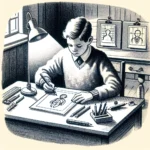The Goodenough-Harris Drawing Test, known to many professionals in the field of psychology and child development, is an important tool used to assess the intelligence and cognitive abilities of children. This test, which has evolved from the Goodenough Draw-A-Man test, allows researchers, educators, and psychologists to gain insight into a child’s developmental progress and can be used to identify potential learning difficulties and cognitive challenges.
The Concept and Origin of the Goodenough-Harris Drawing Test
The Goodenough-Harris Drawing Test is based on a simple yet profound concept: children’s drawings can be an illustrative reflection of their intelligence. Initially developed by Florence Goodenough in 1926, the test was originally known as the Goodenough Draw-A-Man test, inviting children to draw a person. The test was designed to evaluate children’s mental age through a scoring system based on the accuracy and detail of their drawings. Dale B. Harris later revised and extended the test into the Goodenough-Harris Drawing Test in 1963, making it more comprehensive and including a wider range of drawing skills. It consists of a series of drawing tasks that children are asked to complete, frequently involving drawing a man, a woman, and themselves.
How the Goodenough-Harris Drawing Test Works
During the Goodenough-Harris Drawing Test, children are provided with paper and pencils and are instructed to draw human figures. The instructions given are deliberately simple to ensure that the child’s drawing is not influenced by the examiner. Typically, children are asked to draw a man, a woman, and themselves, but separate drawings may be requested. Each drawing is subsequently scored based on a detailed criterion that analyzes specific features of the figures, such as the presence and correct placement of body parts, clothing details, and overall proportion and symmetry.
The test’s scoring system is designed to convert the visual details into quantifiable data that correlates with a child’s cognitive development. Each correctly drawn feature, such as arms, legs, or facial features, earns the child a certain number of points. The total points can then be used to draw conclusions about the child’s intellectual functioning relative to their age group.
Applications of the Goodenough-Harris Drawing Test
The Goodenough-Harris Drawing Test has broad applications in both educational and clinical settings. In schools, it can be used as part of a comprehensive assessment to identify children who may need additional support with their cognitive development or who show signs of exceptional talent. In clinical psychology, the test can help diagnose developmental disorders, monitor a child’s progress over time, and even contribute to treatment planning.
Additionally, the test is an invaluable research tool, contributing to studies on developmental psychology, and it helps in understanding the relationship between drawing skills and overall cognitive development. The simplicity and noninvasive nature of the test make it particularly appealing for working with young children, as it minimizes the stress and resistance that can be associated with more direct testing methods.
Benefits and Limitations of the Goodenough-Harris Drawing Test
One of the major benefits of the Goodenough-Harris Drawing Test is its nonverbal nature, which allows it to be utilized across different cultures and languages. This universality is crucial for obtaining accurate assessments in multicultural environments and reduces the biases that may come from language-based or culturally specific tests.
Moreover, the test can be administered quickly and does not require any specialized equipment, which makes it accessible to a wide range of professionals. The process is also engaging for children, who often enjoy the opportunity to express themselves through drawing, ensuring that the assessment reflects their natural abilities rather than their test-taking skills.
However, while the Goodenough-Harris Drawing Test has proven valuable, it is not without its limitations. The interpretation of the results can be subjective, and scoring may vary depending on the examiner’s experience and perspective. To counteract this, thorough training and standardized scoring guides are essential for those administering the test.
Additionally, the test primarily focuses on cognitive development and does not take into account emotional, social, or behavioral factors that may influence a child’s drawing. It’s also important to note that drawing ability can be affected by motor skills development, which may not necessarily correlate with cognitive intelligence.
Interpreting the Results
It’s crucial to consider the context of the child’s background when interpreting the results of the Goodenough-Harris Drawing Test. Factors such as exposure to art, cultural differences in perceptions of human figures, and even parental encouragement can all influence a child’s drawing abilities. As such, examiners must be culturally sensitive and aware of the child’s environment to accurately interpret the assessments. The results should be seen as one piece of a larger puzzle, often used in conjunction with other tests and observations to form a holistic view of a child’s development.
Conclusion
The Goodenough-Harris Drawing Test remains a valuable psychological tool for assessing children’s cognitive development. Its simplicity, accessibility, and ability to transcend cultural and linguistic barriers make it a unique and widely used assessment instrument. When applied appropriately and interpreted with care, the test can provide significant insights into a child’s development, help identify potential challenges, and guide decisions on educational or psychological interventions.
For professionals utilizing the Goodenough-Harris Drawing Test, it’s essential to approach it with an understanding of its strengths and limitations, taking care to avoid making overgeneralizations from a single drawing. When integrated thoughtfully into a broader assessment strategy, the Goodenough-Harris Drawing Test can serve as a powerful window into the developing minds of children.

